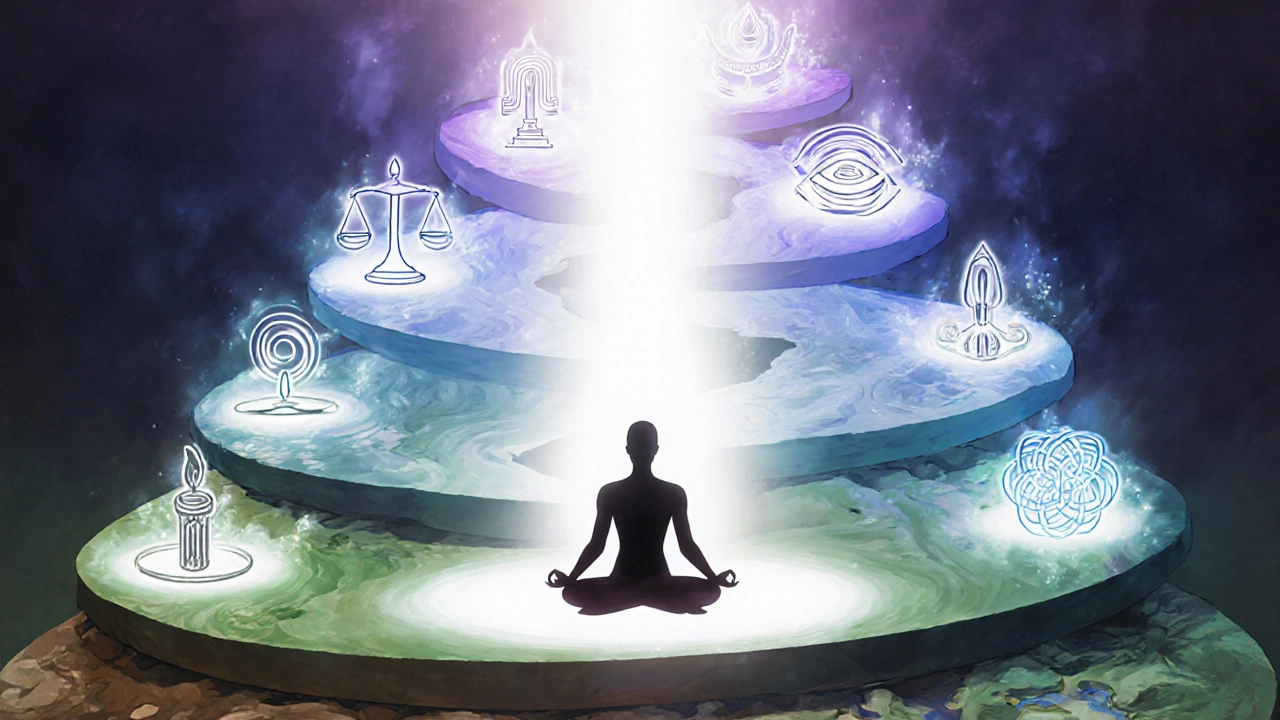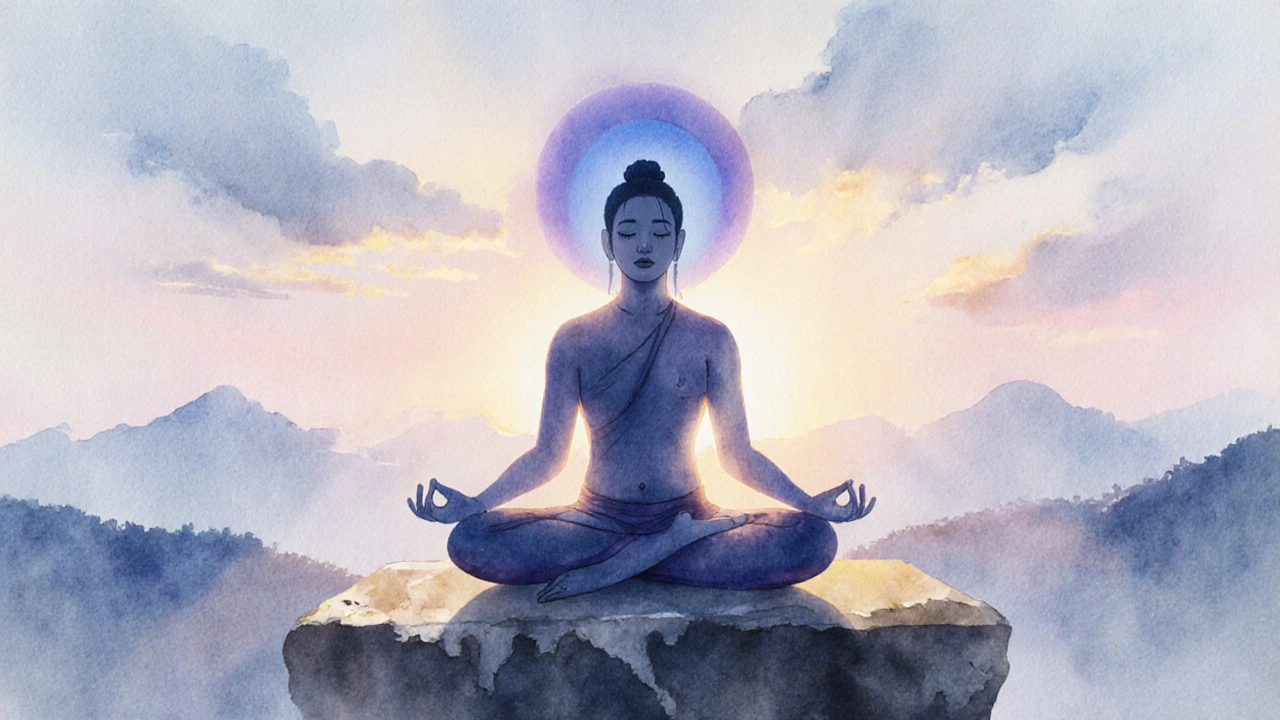Yogi Qualities Assessment
Answer the following questions honestly to assess your alignment with yogic principles. Each question relates to one of the eight limbs of yoga.
Complete the quiz to see how well you embody the spiritual qualities of a yogi and understand the eight-limb path.
When you hear the word Yogi is a person who practices yoga with a deep spiritual focus, seeking inner transformation and union with the divine, you might picture someone in a lotus pose. Most people associate the term with physical flexibility, but spiritually a yogi is far more than a fitness enthusiast. This article breaks down the true spiritual essence of a yogi, tracks its roots in ancient traditions, and shows how anyone can adopt yogic qualities in everyday life.
Key Takeaways
- A yogi is defined by inner work-meditation, ethical living, and the pursuit of enlightenment-not by external displays of flexibility.
- The path to becoming a yogi follows the classic eight‑limb framework of Yoga (the disciplined system that integrates body, mind, and spirit).
- Core spiritual concepts such as Samadhi (the state of deep, unbroken meditative absorption) and Enlightenment (the realization of one’s true nature beyond ego) are milestones on the yogic journey.
- Modern usage often dilutes the term; understanding the original spiritual context helps avoid misconceptions.
- Practical daily practices-mindful breathing, ethical choices, and regular meditation-can cultivate yogic qualities without needing a studio.
What a Yogi Is, Spiritually
The word "yogi" comes from the Sanskrit root *yuj*, meaning "to unite" or "to yoke." In the spiritual sense, a yogi strives to unite the individual self (atman) with the universal consciousness (brahman). This union is not an abstract idea; it’s experienced through disciplined inner work that calms the mind, purifies the heart, and awakens deeper awareness.
Historical Roots: From the Vedas to the BhagavadGītā
Ancient Indian texts such as the RigVeda and the Upanishads already mentioned seekers who practiced self‑control and meditation. Later, the **BhagavadGītā** describes Krishna calling Arjuna a "yogi" for his willingness to act without attachment. The classic Yoga Sutras of Patanjali (2ndcenturyCE) formalized the eight‑limb path that still defines a yogi today.

Core Spiritual Concepts Linked to a Yogi
Several key ideas repeatedly appear in yogic literature. Understanding them clarifies what it means to live as a yogi.
- Enlightenment (the direct experience of one's true nature beyond mental constructs) - The ultimate goal, often described as “awakening” or “liberation (moksha).”
- Samadhi (the state of deep, unbroken meditative absorption wherein the observer and observed merge) - A milestone indicating that the mind has quieted enough to glimpse enlightenment.
- Chakra (energy centers along the subtle spine that regulate physical, emotional, and spiritual flow) - Yogis work to balance these centers through breath, posture, and mantra.
- Guru (a spiritual teacher who guides the aspirant through disciplined practice and insight) - Traditionally, the guru‑shishya (teacher‑student) relationship is a cornerstone of authentic yogic training.
- Karma (the law of cause and effect governing actions, thoughts, and their consequences) - A yogi cultivates positive karma through selfless service (seva) and ethical living.
- Meditation (the focused practice of stilling the mind to observe inner reality) - Serves as the primary tool for moving toward Samadhi.
The Eight‑Limb Path of Yoga: Blueprint for the Yogi
| Limb | Key Practice | Spiritual Result |
|---|---|---|
| Yama (Ethical Restraints) | Non‑violence, truthfulness, non‑stealing, continence, non‑possessiveness | Creates a clean moral foundation for inner work |
| Niyama (Observances) | Cleanliness, contentment, disciplined study, self‑surrender, dedication to the divine | Builds personal discipline and devotion |
| Asana (Posture) | Physical poses that stabilize the body | Prepares the vessel for deeper breath work and meditation |
| Pranayama (Breath Control) | Techniques like alternate nostril breathing, kapalabhati | Calms the nervous system and awakens prana (life force) |
| Pratyahara (Sense Withdrawal) | Turning awareness inward, reducing external distractions | Enables deeper concentration |
| Dharana (Focused Attention) | Fixing the mind on a single point or mantra | Strengthens mental clarity |
| Dhyana (Meditation) | Uninterrupted flow of attention | Creates the fertile ground for Samadhi |
| Samadhi (Absorption) | Complete merging of observer and observed | Experiencing Enlightenment, the yogi’s ultimate aim |
Each limb builds on the previous one. A true yogi doesn’t jump straight to advanced meditation; they first cultivate ethical integrity (yama) and personal discipline (niyama). This graduated approach ensures lasting spiritual growth.
Modern Usage vs. Traditional Meaning
Today, “yogi” appears on yoga‑studio flyers, fitness‑app icons, and even pizza‑topping memes. While the word has become mainstream, the original spiritual depth often gets lost. The modern commercial picture emphasizes flexibility, trendy poses, and Instagram‑ready backbends. The traditional view, however, sees flexibility as a by‑product of inner steadiness, not the end goal.
Confusing the two can lead to disappointment: someone may feel they’re not a "real" yogi because they can’t touch their toes, while the ancient definition would say they’re missing the heart of the practice.

How to Cultivate Yogi Qualities in Everyday Life
- Start with Ethical Choices - Apply the yamas in daily interactions: practice truthfulness at work, avoid harming living beings, and let go of material greed.
- Adopt a Simple Routine - Even five minutes of seated meditation each morning anchors the mind and begins the path toward dharana and dhyana.
- Integrate Breath Work - Use a quick pranayama technique like 4‑4‑6 breathing during stressful moments to calm the nervous system.
- Balance the Chakras - Visualize a spinning wheel of light at the base of the spine (root chakra) and slowly move upward, spending a minute on each energy center.
- Find a Mentor or Community - Join a local meditation circle or follow a respected teacher online; the guru‑shishya bond can accelerate insight.
- Serve Selflessly - Engage in small acts of kindness (seva) without expecting recognition; this purifies karma and softens the ego.
- Reflect Regularly - Keep a journal of thoughts, emotions, and any subtle shifts in perception. Tracking progress prevents stagnation.
Notice how each step mirrors a limb of the eight‑fold path. By integrating them gradually, you embody the spirit of a yogi without needing a gym membership.
Common Pitfalls to Avoid
- Focusing Only on the Physical - Using yoga solely as a workout leads to muscular tension that blocks breath and meditation.
- Seeking Immediate Enlightenment - Spiritual growth is incremental; expecting instant Samadhi creates frustration.
- Comparing Yourself to Others - The yogic journey is personal; external benchmarks erode inner humility.
- Neglecting Ethics - Skipping yamas and niyamas creates mental dissonance, making deep meditation difficult.
Awareness of these traps keeps you on a steady, authentic course.
Frequently Asked Questions
Can anyone become a yogi, or is it reserved for advanced practitioners?
Anyone can adopt the yogic mindset. The title "yogi" isn’t tied to how flexible you are but to your commitment to inner discipline, ethical living, and meditation. Even a few minutes of mindful breathing each day puts you on the path.
What’s the difference between meditation and Samadhi?
Meditation (dhyana) is a sustained practice of focused attention. Samadhi is the natural result when that practice deepens to the point where the mind no longer creates a separate observer. Think of meditation as the ladder and Samadhi as the topmost rung.
Do I need a guru to become a yogi?
A guru isn’t mandatory, but guidance from an experienced teacher can clarify doubts, correct misconceptions, and provide personalized practices. If a formal guru isn’t accessible, trustworthy books and reputable online courses can serve as substitutes.
How does karma affect my yogic progress?
Karma shapes the mental and emotional patterns you bring to practice. Positive actions generate supportive conditions for meditation, while negative habits create resistance. By cultivating wholesome deeds, you cleanse the mind, making it easier to experience deeper states like Samadhi.
Is it okay to practice yoga without any religious belief?
Absolutely. The spiritual framework of yoga is philosophical rather than doctrinal. Whether you identify as Hindu, Buddhist, secular, or agnostic, the inner work-ethical living, breath awareness, meditation-remains applicable and beneficial.
